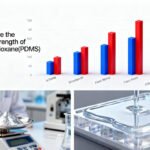How is Silicone Fluid Manufactured?
- Blog
- February 20, 2025
- 2:51 pm
Silicone fluid, scientifically known as polydimethylsiloxane (PDMS), is a high-performance silicon-based polymer widely used across various industries such as cosmetics, pharmaceuticals, electronics, and industrial manufacturing. Due to its excellent thermal stability, chemical inertness, and superior lubrication properties, Silicone fluid has become an indispensable material in many advanced applications.
In this detailed article, we will walk you through how silicone fluid is produced step by step, revealing the sophisticated chemical processes, advanced manufacturing techniques, and quality control measures that ensure the production of high-grade silicone fluid suitable for diverse industrial uses.
Table of Contents
- 1. Understanding Silicone Fluid and Its Chemical Structure
- 2. Step-by-Step Process of Silicone Fluid Manufacturing
- 3. Types of Silicone Fluid and Their Applications
- 4.Quality Control in Silicone Fluid Manufacturing
- 5.Environmental and Regulatory Considerations
- 6. Choose Silico® – Your Trusted Partner in Silicone Fluid Solutions
1. Understanding Silicone Fluid and Its Chemical Structure
The production of silicone fluid primarily relies on the following raw materials:
Silica (SiO₂) – The fundamental silicon source extracted from quartz sand.
Methyl Chloride (CH₃Cl) – A methylating agent essential for creating silicon-carbon bonds.
Catalysts (e.g., NaOH or KOH) – Used in hydrolysis and polymerization steps.
Water – Necessary for hydrolysis and condensation reactions.
2. Step-by-Step Process of Silicone Fluid Manufacturing
(1). Monomer Synthesis – The Rochow Process
The foundation of silicone fluid production lies in synthesizing chlorosilanes through a high-temperature direct reaction between methyl chloride and elemental silicon in the presence of a copper-based catalyst. This is known as the Rochow Process.
Si + CH₃Cl → (CH₃)₂SiCl₂, (CH₃)₃SiCl, etc.
This process yields various chlorosilane intermediates like Dimethyldichlorosilane, which are then separated through distillation.
(2). Hydrolysis and Condensation
Chlorosilanes are hydrolyzed with water to form silanols and hydrogen chloride. These silanols undergo condensation reactions to form linear siloxane chains—the core structure of PDMS.
(CH₃)₂SiCl₂ + H₂O → (CH₃)₂Si(OH)₂ → -(Si(CH₃)₂-O)-n
This critical step creates low-molecular-weight silicone fluids, the building blocks for further polymerization.
(3). Ring Opening Polymerization (ROP)
Using a basic catalyst (e.g., KOH), cyclic siloxanes like D4 and D5 are polymerized into linear silicone fluids. The chain length and viscosity are controlled by adjusting reaction time, temperature, and end-blocking agents.
This step is central to industrial-scale silicone fluid production and determines the final product’s viscosity and performance characteristics.
(4). Neutralization and Chain Termination
After polymerization, the catalyst is neutralized (often using phosphoric acid) and chain termination is performed using agents like hexamethyldisiloxane (MM). This helps achieve consistent molecular weight distribution and enhances thermal and oxidative stability.
(5). Filtration and Vacuum Distillation
The final silicone fluid is purified by removing unreacted monomers and volatile compounds through vacuum stripping and fine filtration. This ensures a high-purity, crystal-clear silicone fluid suitable for medical, cosmetic, and industrial use.
3. Types of Silicone Fluid and Their Applications
| Type | Structure | Key Applications |
|---|---|---|
| Low-Viscosity PDMS | Short linear chains | Eye drops, antifoam agents, heat transfer fluids |
| Medium to High Viscosity | Long linear chains | Hair serums, lubricants, polishes, dielectric fluids |
| Amino Silicone Fluid | Modified with amine | Textile softeners, fabric finishing agents |
| Phenyl Silicone Fluid | Contains phenyl groups | High-temperature lubricants, insulating fluids |
| Volatile Siloxanes (D4/D5) | Cyclic structure | Skin care formulations, carrier solvents in deodorants |
For manufacturers looking to develop custom silicone formulations, understanding these types is crucial in selecting the right PDMS grade for specific performance and safety standards.
4. Quality Control in Silicone Fluid Manufacturing
To meet global market demands, silicone fluid production must conform to strict quality assurance protocols, including:
Precise viscosity measurement (ranging from 5 cSt to over 1,000,000 cSt)
Low volatile content (typically < 0.5%)
High thermal and oxidative stability
Compliance with REACH, RoHS, FDA, ISO9001, and cosmetic-grade certifications
Advanced laboratories perform GC analysis, FTIR, and viscometry to ensure consistency and safety across all batches.
5. Environmental and Regulatory Considerations
In response to environmental concerns, leading silicone manufacturers are implementing:
Low-VOC production processes
Recycling of chlorosilane by-products
Eco-friendly catalysts with reduced metal content
Development of biodegradable silicone alternatives
As regulatory scrutiny grows—especially around cyclic siloxanes (like D4 and D5)—choosing a responsible silicone oil supplier is more important than ever.
Choose Silico® – Your Trusted Partner in Silicone Fluid Solutions
Silico® specializes in high-quality, customizable silicone fluid products tailored for a wide range of applications—from personal care and industrial lubrication to electronics and medical-grade fluids.
Why global buyers trust Silico®:
✅ Over 10 years of export experience
✅ OEM and private-label options available
✅ Certified by international quality standards
✅ Environmentally conscious production practices
✅ Technical support for formulation and application
Whether you need Low-Viscosity PDMS for spray formulations or ultra-high viscosity silicone fluids for specialty applications, Silico® offers consistent, reliable, and scalable solutions.
👉 Learn more or request samples at silicorex.com
Popular Recommendations
Get a Catalog & Best Price
- Quick and helpful reply within 24 hours;
- Tailored solutions provided for your project;
- One-stop purchasing service.
TRENDING
Silico® ORGANOSILICON
- Address: Daiyue Industrial Area, Taian, Shandong, China



